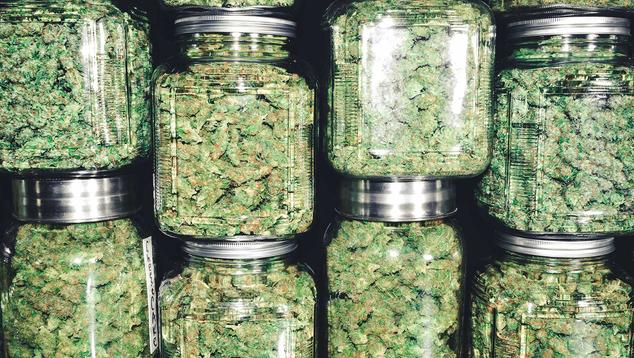WASHINGTON, D.C. -- Nine percent of U.S. adults report that they use cannabis regularly, defined as at least 10 days of consumption per month. Regular usage differs by education and income, with the highest rates seen among those with a high school education or less (13%) and those living in households earning less than $24,000 per year (16%). These consumption levels are about three times the rates found among those with postgraduate work or degrees (5%) and those living in households earning $180,000 or more annually (5%).
This analysis is part of the Gallup National Health and Well-Being Index. The results are based on a web survey of 6,386 U.S. adults, conducted Nov. 30-Dec. 8, 2023, as part of the Gallup Panel, a probability-based, non-opt-in panel encompassing all 50 states and the District of Columbia. To measure cannabis use, Gallup asked: “Keeping in mind that this is confidential, how many days in the last month have you used cannabis products (such as smoking marijuana, vaping liquid THC, or consuming baked goods or gummies) to alter your mood and help you relax?”
About one in five adults (19%) report using cannabis products at least once in the prior month, including 23% of those with a high school degree or less and 28% of those in households earning under $24,000 per year.
Regular Cannabis Use Diminishes With Age, Slightly Higher Among Men
In addition to education and income, other factors are associated with greater use of cannabis. Adults younger than 50, for example, are twice as likely as those aged 65 and older to be regular cannabis users (12% vs. 6%, respectively). Men (11%) are marginally more likely than women (8%) to be regular consumers, while little difference is found among White, Black and Hispanic adults.
Cannabis Use Highest in East North Central and New England Areas
Reports of regular cannabis use vary across the U.S. Census divisions. The highest rates of use (11%) are found in the Middle Atlantic (New York, Pennsylvania and New Jersey) and East North Central divisions (Wisconsin, Michigan, Illinois, Indiana and Ohio). The lowest usage rates (7%) are reported in the East South Central (Kentucky, Tennessee, Mississippi and Alabama) and the West North Central (North Dakota, Minnesota, South Dakota, Nebraska, Iowa, Kansas and Missouri) divisions. These differences are statistically meaningful.
These results generally align with political identity, with residents of politically red states having somewhat lower regular usage rates than politically blue states. While regular use is reported by 10% of Democrats and independents, it drops to 6% among Republicans.
When sorted into states that have legalized marijuana versus those that have kept it illegal, however, little differences in usage exist:
- In states that have legalized marijuana: average of 2.9 days of cannabis consumption per month per person, with 9.7% regular users
- In states that have not legalized marijuana: average of 2.5 days of cannabis consumption per month per person, with 8.6% regular users
Implications
In the U.S., cannabis is fully legal in 18 states and legal for medicinal purposes in 12 states. Another eight states have decriminalized marijuana, while it is fully illegal in 12 others. Legalization for recreational use was passed initially by voters in Colorado and Washington in 2012, with the commercial sale of marijuana to the general public available in both states in 2014. Nationally, 70% of adults now favor the legalization of marijuana for recreational use, an all-time high across over 50 years of measurement and up from 25% as recently as 1995. The narrow gap in cannabis consumption among residents of states where it remains illegal compared with those in states where it is legal suggests that its criminalization does little to curtail its use among American adults.
Dovetailing with broadening legalization, the percentage of U.S. adults who report that they smoke marijuana has more than doubled in the past decade, climbing from 7% in 2013 to 17% in 2023. During that same period, the percentage reporting that they have tried it at least once has climbed from 38% to 50%. (It is worth noting that respondents may have also become more comfortable admitting to its use as its legality has widened.)
How users consume cannabis has also evolved in recent years. For example, CDC BRFSS data show that among those who had consumed cannabis by any means in the prior 30 days, the proportion who primarily chose vaping to do so increased from 9.9% to 14.9% between 2017 and 2019 alone -- and has likely increased since that time, particularly among young adults.
Marijuana use can be addictive, with one study1 estimating that about three in 10 users form marijuana use disorder and a different study2 estimating that about 10% of cannabis users will become addicted. The use of marijuana during adolescence or young adulthood can affect how the brain builds connections for functions like attention and memory. Its use has also been linked to depression, anxiety and suicide. That cannabis use skews toward younger, less educated and lower-income individuals is consistent with previously existing research across an array of different substances and supports the need for early detection and intervention for at-risk individuals.
Learn more about how the Gallup National Health and Well-Being Index works.
Learn more about how the Gallup Panel works.
Footnotes
[1] Hasin, D.S., Saha, T.D., Kerridge, B.T., et al. Prevalence of marijuana use disorders in the United States between 2001-2002 and 2012-2013. JAMA Psychiatry. 2015. 72(12): 1235-1242.
[2] Lopez-Quintero, C., de los Cobos, J.P., Hasin, D.S., et al. Probability and predictors of transition from first use to dependence on nicotine, alcohol, cannabis, and cocaine: Results of the National Epidemiologic Survey on Alcohol and Related Conditions (NESARC). Drug and Alcohol Dependence. 2011. 115(1-2): 120-130.




